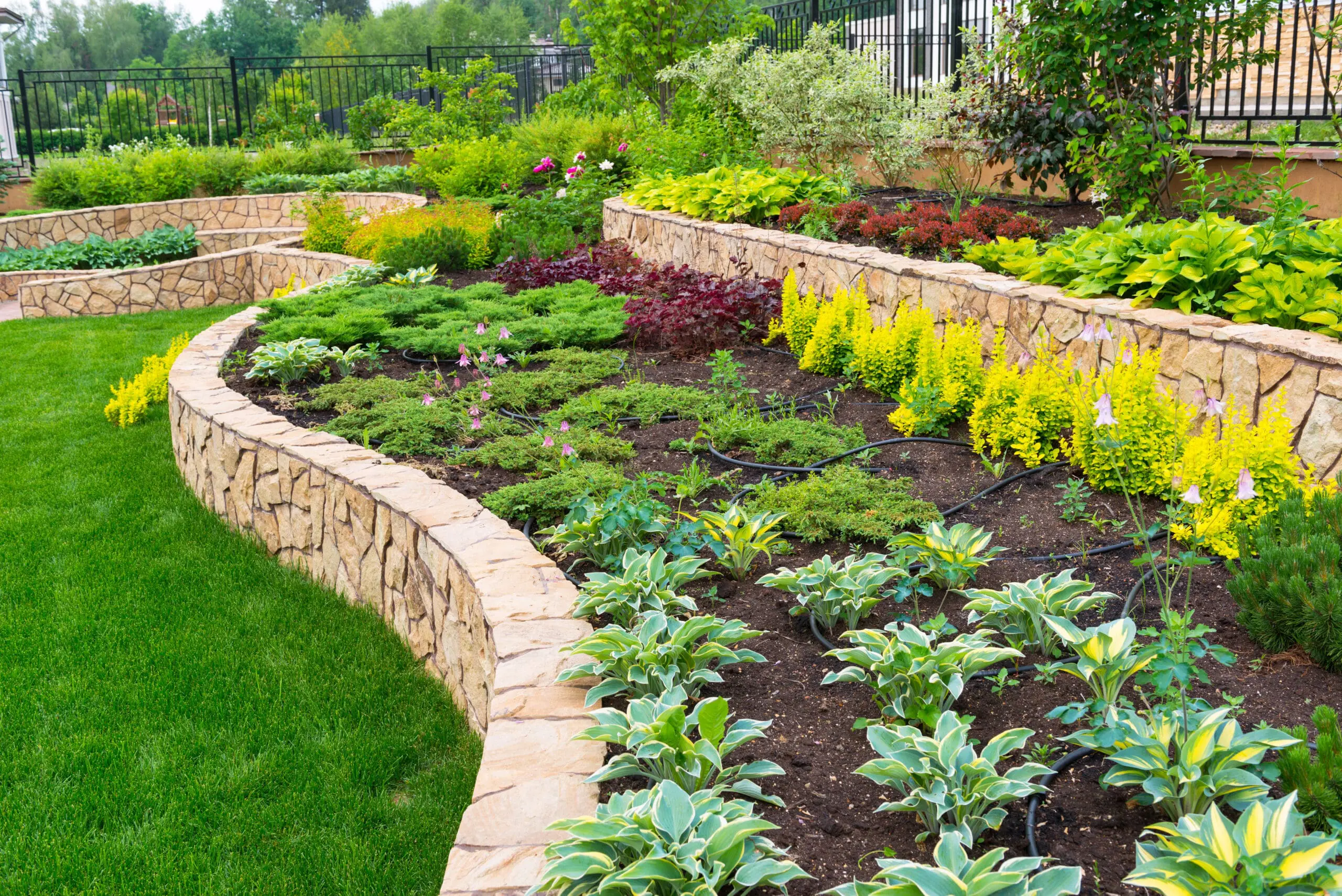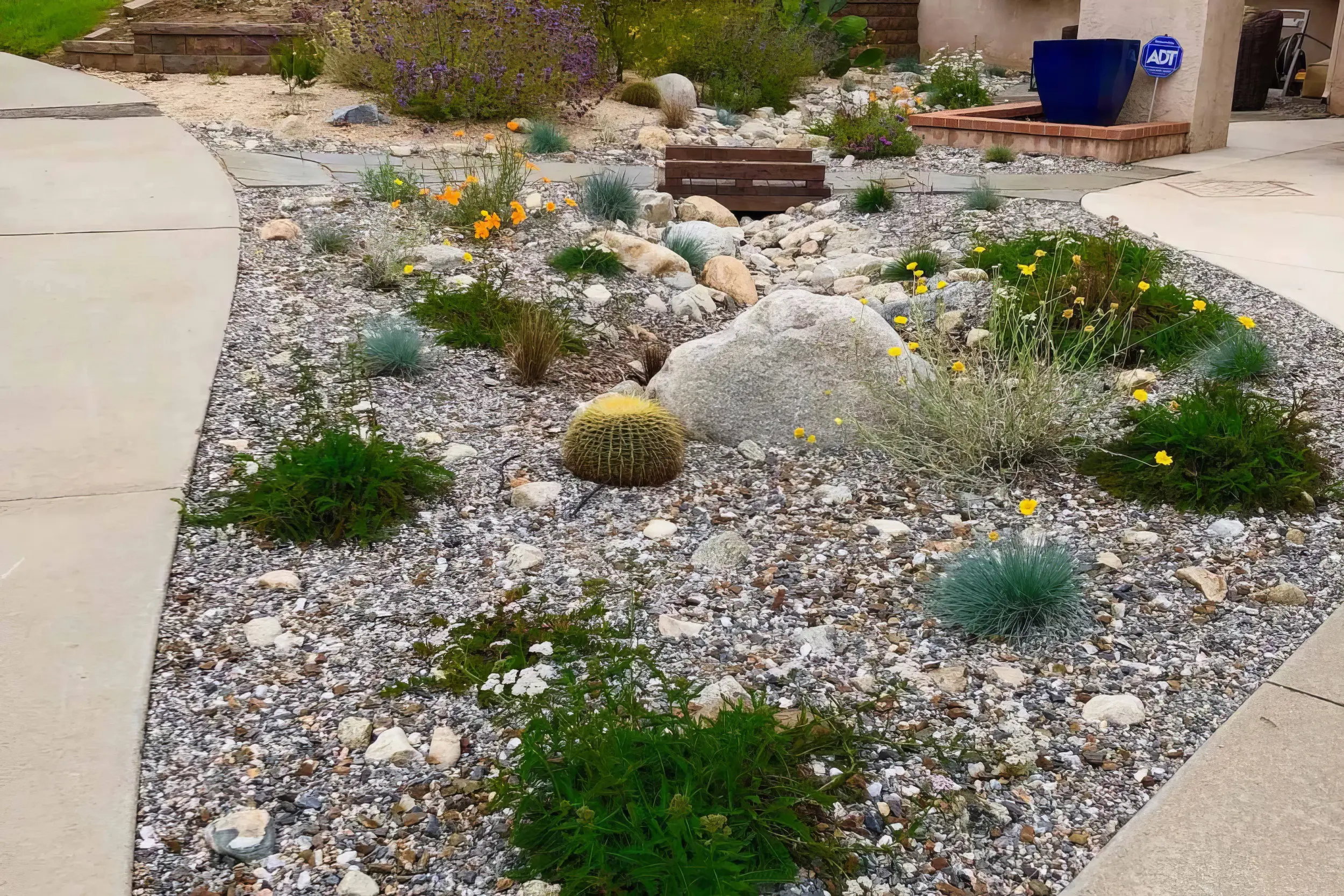IN THE EVENT OF AN EMERGENCY THIS SITE IS NOT MONITORED. FOR CURRENT INFORMATION GO TO HTTPS://EMERGENCY.MARINCOUNTY.GOV.
Fire Smart Landscape Basics
Firescaping uses fire-resistant designs and materials, in conjunction with careful selection of plants, to strategically resist the spread of fire to your home.
What is Firescaping?
In the face of escalating wildfire threats across various regions, homeowners and communities are turning to innovative solutions to safeguard their properties. One such approach gaining popularity is “firescaping,” a strategic and intentional landscaping technique designed to mitigate the risk of wildfires. Firescaping involves creating a defensible space around homes using fire-resistant plants, proper spacing, and other landscaping practices.You don’t necessarily need to spend much money to make your landscaping more fire-resistant. A fire-resistant landscape can increase your property value and conserve water while also beautifying your home.

This yard shows plant separation, good use of mulch and hardscape, and shaded fuel breaks on the hillside
Benefits of Firescaping:
- Increased Safety: The primary goal of firescaping is to create a buffer zone that protects homes and structures from the immediate threat of wildfires. By implementing fire-resistant landscaping techniques, homeowners can significantly reduce the risk of property damage and enhance overall safety.
- Environmental Sustainability: Firescaping often involves the use of native, drought-tolerant plants, contributing to the conservation of water resources. Additionally, maintaining a well-balanced ecosystem helps support local wildlife and biodiversity.
- Aesthetic Appeal: Contrary to the misconception that fire-resistant landscaping compromises aesthetics, firescaping can be visually appealing. Thoughtful plant selection and design can create beautiful, resilient landscapes that enhance property value.
Firescaping represents a proactive and sustainable approach to wildfire prevention. By adopting this method, individuals and communities can significantly reduce the vulnerability of their homes to wildfires while simultaneously promoting environmental consciousness. As the threat of wildfires continues to grow, embracing firescaping is a practical and effective strategy for safeguarding lives, properties, and the natural landscape.

Large stones for hardscape, good mulch selection, nice plant spacing
How to Create a Fire Smart Firescape
- Create ember resistant zones with non combustible materials like gravel mulch, stones and boulders, hardscape, cement/stome retaining walls, patios, swimming pools, walkways, and paths.
- Use rock, composted or heavy bark mulch in flower beds and gardens as ground cover for bare spaces to act as effective firebreaks.
- There are no “fire proof” plants, but some are better choices for landscaping than others. Choose plant species that resist ignition. Learn how to select fire-smart plants in Marin County.
- Choose broad-leafed hardwood trees that are less combustible than pine, fir, and other conifers. Learn how to select fire-smart trees in Marin County.
Check your with the UCCE Marin Master Gardeners, your local nursery, or landscape contractor for advice on specific plants that are suited for your environment and help to plan your landscape.
Choose Fire-Smart Plants
See our guidelines for choosing plants and specific species recommendations in Marin County. Some landscape plants are described and marketed as fire-resistant, but Fire Safe Marin and the UCCE Marin Master Gardeners both agree that given certain conditions, all plants can burn regardless of how they are classified.
In general, select plants that are low growing, open structured, and less resinous. How your plants are maintained and where they are placed is as important as the species of plants that you choose. Cultural practices and landscape management (e.g., pruning, irrigation, and cleanup) often have a greater impact on whether or not a plant ignites than does the actual species.
When choosing plants for firescaping, select those with the following characteristics:
- High moisture content in leaves (as these ignite and burn more slowly).
- Deciduous trees are generally more fire-resistant than evergreens because they have higher moisture content when in leaf.
- Little or no seasonal accumulation of dead vegetation.
- Open branching habits (as they provide less fuel for fires).
- Fewer total branches and leaves (again, less fuel for fires).
- Slow growing, so less pruning is required (to keep the plant structure open, as noted above).
- Non-resinous (i.e., stems, leaves, or needles that are not resinous, oily, or waxy). Junipers, pines, spruces, and many other conifers are resinous and highly combustible.
Use Non-Combustible Materials
Retaining walls can disrupt airflow, creating wind “eddies” that may help keep embers away from your house. Use masonry, gravel, or stone walls to separate plant groups, adding variety and improving the fire resistance of your landscape. Another way to break up fuel continuity is to use decorative rock, gravel and stepping stone pathways, cement driveways and walkways, and retaining walls, as your landscape’s “hardscape” that will be less combustible. Replace bare, weedy, or unsightly patches near your home with ground cover, rock gardens, vegetable gardens, and fire-resistant mulches.

In this image from the Kinkade Fire (2019 Sonoma County), a retaining wall prevents the spread of ground fire to the structure and to near-home landscaping, and redirects heat and embers away from the home. Photo credit: Max Whittaker, New York Times.

Bark mulch burning near a home that has been destroyed in the Kincade Fire in 2019. Photo credit: New York Times
Use the Right Mulch
Mulch conserves moisture, but also burns. Carefully choose the location of plants or garden beds that will need mulch. Mulches are valuable because they conserve moisture, reduce weed growth, and also cover up weed cloth. Compost and large bark chips are usually the best options for fire resistance.
“Gorilla Hair” and other shredded bark mulches should be avoided within 30 feet of any structure. They burn hot and are extremely susceptible to ignition from embers. The Boy Scouts teach fire-starting in survival situations and even sing about shredded bark.
Be careful not to use too much bark mulch in garden beds near your home or outbuildings. Composted mulch is the best choice because it is:
- less prone to ignition
- smolders rather than igniting with longer flames, making it less likely to ignite neighboring materials
- tends to burn relatively slowly
Do not use wood or bark mulches within three to five feet of the house. Instead, consider colored rock or other less combustible material. Learn more about fire-resistant mulch.
How To Plant & Maintain Vegetation
Healthy lawn, ground cover, and perennials should form a greenbelt in the home defense zone. Plants that are green and lush give better protection. If regularly watered and maintained to eliminate the accumulation of dry plant litter, these plants will be far less likely to carry fire to your home.
While all plants can burn, healthy ones with high moisture content will be more difficult to ignite. Proper irrigation for the plant species, soil, and site conditions is critical.
The home defense zone can contain an occasional individual shrub or tree – just be sure it is located at least ten feet from the house. By grouping plants of similar height and water requirements, you can create a landscape mosaic that uses water more efficiently and is more likely to slow the spread of fire.

Where to Avoid Planting
Avoid putting plants in the following locations to minimize the movement of fire from vegetation to the home:
- In the non-combustible zone (zone zero) within five feet of structures
- Adjacent to siding
- Under vents or eaves
- Tree limbs over the roof
- Under or within five feet of decks










